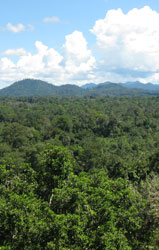|
PROMOTING NATIVE THREATENED TREE SPECIES IN COMMUNITY-BASED FOREST REHABILITATION IN WEST KALIMANTAN, INDONESIA
This project will assist village communities in their effort to restore, rehabilitate, and sustainably utilise deforested and degraded areas within the community forest areas, using native and threatened tree species. It is hoped that community-based native and threatened tree species re-planting will be incorporated into national policies on forest restoration and rehabilitation.
FURTHER INFORMATION
Deforestation and degradation have been occurring at an alarming rate in Indonesian Borneo (Kalimantan) in recent years, with the main drivers being illegal/unsustainable logging, conversion into large and small scale agriculture and forest fires. The loss of forests is resulting in rapid loss of biodiversity and substantial greenhouse gas emissisons.
Since the early 2000s, FFI has been assisting the protection of orangutan populations and improving conservation management of two national parks West Kalimantan. More recently, since 2008, FFI has been working further in promoting sustainable management of high conservation value area in forestry and agricultural concessions and in developing community forestry.
Within West Kalimantan, progress on community forestry development in the Ketapang district has been most promising. Commitment from local communities to protect the forest remains is high, while political supports from the Ministry of Forestry and district government is strong.
In order to gain formal control over their forests, each village community is required to develop and implement forest management plans, which include plans for protection, restoration, rehabilitation, and utilisation zones. Beginning in 2011, the project is working to assist village communities in their effort to restore, rehabilitate, and sustainably utilise deforested and degraded areas within the community forest areas, using native and threatened tree species. Lessons learnt from this project will feed into national policies on community managed forest restoration and rehabilitation.
Update: December 2011
Field surveys and interviews with villagers in four communities have been carried out to gather data on tree species considered by local people to be rare and on local propagation practices for rare trees. This has resulted in a list of six target species, and one target group, the dipterocarps.A report detailing the recommended vegetative propagation techniques for dipterocarps has been produced.
The project is conducting workshops with target communities to promote the planting of threatened species and train them in optimum propagation and planting techniques. Village tree nurseries are being established to produce seedlings of rare species for planting, and, building on the experiences of the project, guidelines on propagation and planting of target threatened species will be produced for distribution in other communities.
Meetings with relevant forest authorities to promote the project concept indicate that there is a good prospect that the practice of re-planting with threatened tree species can be incorporated in provincial and even national policies on forest restoration and rehabilitation, for wider application in the future.
Back to Current Projects
|

|



